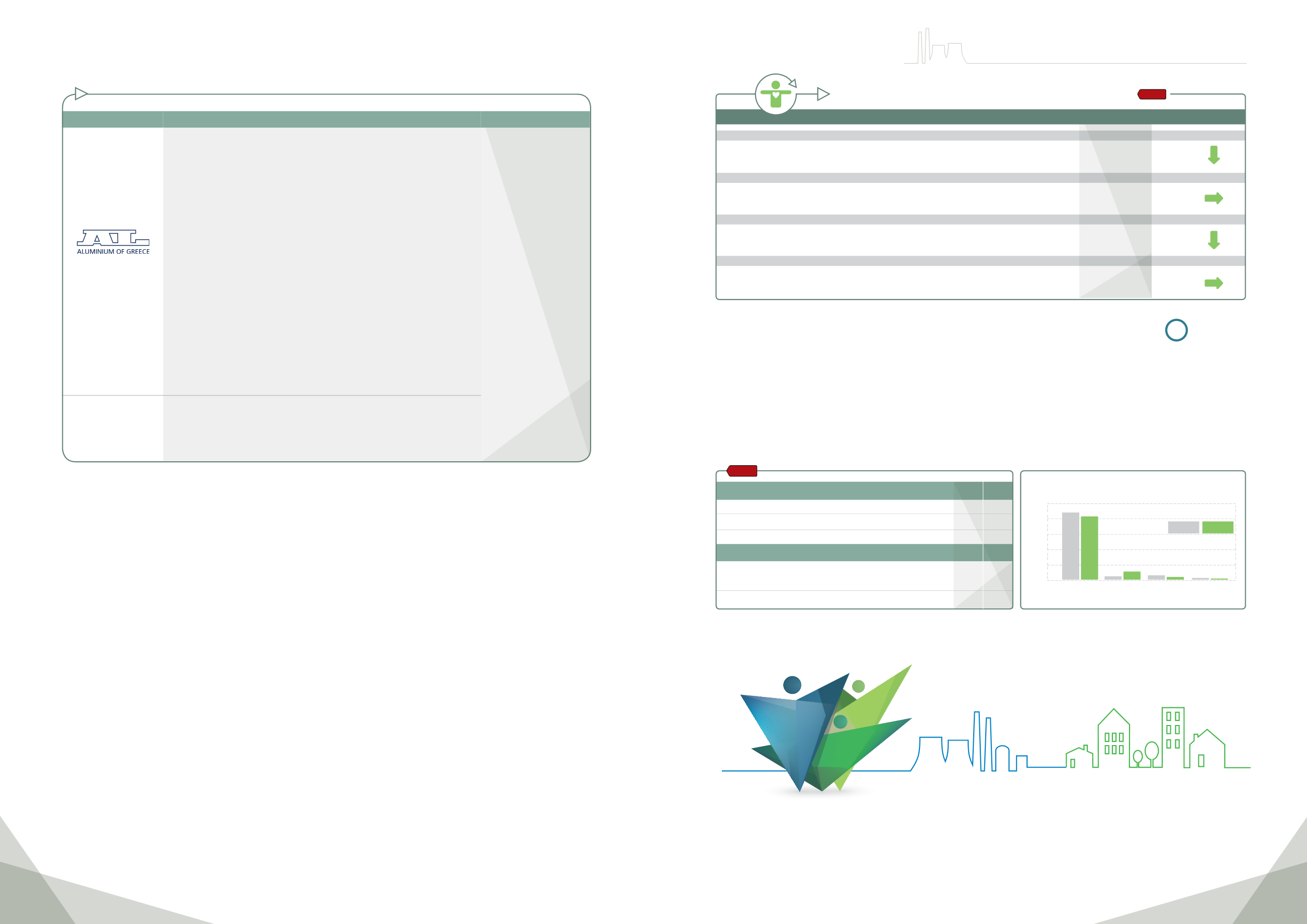
44
45
MYTILINEOS HOLDINGS SUSTAINABILITY REPORT
2015
ed in an interruption of work for three or more days. The imme-
diate actions taken after the accidents, involved the provision of
medical care, consisting in the administration of first aid at the
project site and the transport of the injured employee to an asso-
ciated hospital for further treatment. All the employees involved in
the accidents have now returned to work and the main corrective
actions taken were the following: (a) Unusable/waste materials
were removed from the work areas and (b) the employees of con-
tractors were provided with specific training in work instructions.
9.5 Employee Training & Development
In 2015, a total of 56,540 man-hours were spent on training in all
Group subsidiaries, with nearly 50% of these accounting for train-
ing on Health & Safety. The Group’s total training expenditure
stood at €382,766 and the training cost per employee was nearly
€174.
2015
2014
Injury Rate (IR)
IR (Total)
IR (Men)
IR (Women)
Occupational Diseases Rate (ODR)
ODR (Total)
ODR (Men)
ODR (Women)
Lost Days Rate (LDR)
LDR (Total)
LDR (Men)
LDR (Women)
Absenteeism Rate (AR)
AR (Total)
AR (Men)
AR (Women)
0.46
0.45
0.00
0.00
0.00
0.00
7.76
7.85
0.00
0.00%
0.00%
0.00%
0.37
0.38
0.00
0.00
0.00
0.00
4.47
4.54
0.00
0.00%
0.00%
0.00%
Health & Safety Indicators (Independent contractors personnel)
Change
-19.5%
0%
-42.3%
0%
G4-LA6
Breakdown of training man-hours
by Group’s activity sector
20%
0%
40%
60%
80%
100%
87.5%
85.2%
5.5% 3.9% 1.3% 1.0%
9.9%
5.7%
2014 2015
Average training hours per employee / by gender
2014
2015
Average training hours per employee
25
25.7
Average training hours per employee (Men)
28
27.8
Average training hours per employee (Women)
10
12.3
Average personnel training hours by employment position
2014
2015
Average training hours (Executives)
35
32.7
Average training hours (Administrative employees)
13
17.6
Average training hours (Technical & Labour personnel)
30
33.6
G4-LA9
Metallurgy
& Mining
Sector
EPC
Projects
Sector
Energy
Sector
Corporate
Center
1
4
9
17
20
25
26
27
29
28
21
10
11
12
13
5
2
3
18
19
Group Companies
Main actions taken
Status of employees
• Trial use of face shields and anti-fog closed-type goggles in the work
concerned and adoption as permanent gear if the trial is successful.
• Monitoring of the work by a joint team from the Alumina Production and
Safety Departments, in order to come up with further improvements.
• Posting of a message to raise the employee’s awareness of the need for
adherence to the regulation concerning the use of Personal Protective
Equipment (PPE).
• Changes to work methods, in order to eliminate the relevant risk.
• Accessibility improvements.
• Addition of an escape route check point in the risk identification sheet,
before commencement of the work.
• Briefing of and presentation of incidents to the relevant Functional
Organisational Units.
All the employees
involved in the
accidents are well
and have returned
to work.
DELPHI
DISTOMON
• Training through safety seminars.
• Improvements to the type and number of signage at the accident site.
In the Metallurgy & Mining sector, the Group evaluates its perfor-
mance against to the performance of similar plants and intensi-
fies its efforts for continuous improvement. The investigation of
accidents shows the need for a comprehensive assessment of
the risks present at the workplace, in tandem with the need for
constant alertness in order to prevent them.
In this respect, ALUMINIUM OF GREECE already applies pro-
cedures for recording and investigating potential serious and
non-serious safety incidents which, under certain circumstanc-
es, could lead to accidents. The relevant findings were used to
improve the procedures of safe attitude, the equipment and the
training provided.
Health is an equally important part of the sustainable and re-
sponsible growth of the he Metallurgy & Mining Sector and one
in which the Group has been consistently investing through
ALUMINIUM OF GREECE since its establishment. In 2015, the
company succeeded in reporting, for the fifth consecutive year,
nil incidents related to occupational diseases. This is due to the
implementation of the Occupational Risk Assessment (ORA) pro-
cedure, which refers to all factors in the work environment which
can affect the health of employees and aims to constantly im-
prove work conditions. The ORA is a quantitative tool that relies
on measurements of harmful factors, which as a rule are car-
ried out using personal samplers and, in general, measurement
instruments that employees carry on their person during their
working day. After mathematical processing, these measure-
ments are compared to the exposure limit values determined by
the laws in force. The processing of this data offers the possibility
of establishing a complete record of the exposure of employees
and of developing a comprehensive action plan in order to ensure
achievement of the target of “ZERO OCCUPATIONAL DISEASES AT
WORK”. Today, eight (8) harmful factors are monitored systemati-
cally, including noise, dust, fluorine compounds, sulphur dioxide,
carbon monoxide, polycyclic aromatic hydrocarbons, thermal
shock and beryllium.
Personnel of independent contractors.
Managing the safety of the employees of independent contractors
is a particular challenge for the Group’s subsidiaries, met mainly
through initiatives aimed at improving people’s attitude towards
accident prevention. Despite the fact that the injury rate was sub-
stantially improved by 19.5% in 2015, there were 7 lost-time injury
incidents in the Construction & Infrastructure sector.
The accidents occurred at the METKA’s construction sites. All the
accidents involved male employees and each one of them result-


